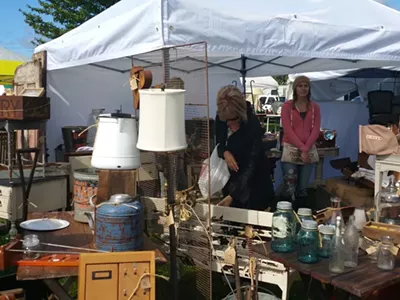In her latest book, Beautiful Terrible Ruins: Detroit and the Anxiety of Decline, art historian and Wayne State University professor Dora Apel explores the portrayal of Detroit in the mass media, specifically the images that have come to be known as "ruin porn." What drives the fascination behind these images, and what do they say (or don't say) about Detroit? We spoke with Apel by phone in advance of her upcoming book talk at MOCAD to learn more.
Metro Times: "Ruin porn" has become a popular topic in recent years.
Dora Apel: In the book I argue that it is a very problematic term. I don't tend to use it. I argue against its usefulness as a general cultural critique. It's meant to be derisive and dismissive, and I what I think it really represents — and I can understand it to a great extent — is a certain resentment. It's really an insider-outsider debate.
My argument is first of all, insiders and outsiders tend to take similar kinds of imagery. So who has the right to take those images does not seem to me to be the crucial question, because everybody wants to shoot the ruins. The more interesting question is why are the ruins so fascinating, and what cultural work do the ruin photos do? That's really what I wanted to explore in the book.
MT: But it's not unique to Detroit. There's a tradition viewing and preserving ruins throughout history, right?
Apel: I argue that industrial ruins are different than classical ruins. I think the reasons for ruin-gazing have kind of changed over the centuries. The "grand tour," say, of the 18th century consisted of lots of Europeans, especially those of the British empire, touring classical ruins in Greece and Rome and the Middle East. In part, that was to gaze on the decline of other civilizations in order to prepare themselves to become the ideological leaders of the world. There's a certain pleasure in gazing on the ruins of other civilizations because it tends to validate the superiority of your own. But it's very different when you are gazing on the ruins of your own nation.
MT: Especially gazing on ruins of the things that once made it great.
Apel: Exactly. I think that's one of the reasons why Detroit has become the quintessential example of ruination — it's also the cradle of modernity. This is where the assembly line was invented, and the basis for modern industry. It was once seen as the world leader of modern industry, so it's particularly poignant to see the decline here. It's certainly not just here — every traditional manufacturing center is in decline. But the scope of it is greater, and the symbolic value of it in Detroit is greater.
MT: The symbolic aspect is important. It seems like there's two Detroits — the media version of Detroit and then the reality. And it's not just ruins. There's also the opposite depiction, which can also be equally misleading, of showing Detroit as this haven for artists and young entrepreneurs.
Apel: Yes, there are two extremes. It tends to be represented in the media as a ghost city that's already dead and mummified, or the opposite — that the gentrification in Midtown or downtown is renewing and reviving the city. Each of those are exaggerated.
MT: There should be a term for that — the opposite of ruin porn.
Apel: "Hope porn." [Laughs.] Actually, I didn't coin that. Oren Goldenberg has created this series of videos, they're called Detroit (Blank) City. He talks about "hope porn." He satirizes everything, really, but he satirizes the ideas that urban gardens are going to save the city, or that gentrification will save the city.
The city needs a lot more than new stores opening in a little section of town. It needs a massive jobs program. It needs massive renewal of infrastructure, it needs a transportation system that is efficient and connects the city to the suburbs. It needs access for the population to healthcare and education. The problems are much bigger than what gentrification can solve. And gentrification causes new problems.
MT: These are complex issues, and people want their stories to be told quickly — hence the appeal of images.
Apel: You know, I'm not critical of ruin images as a genre. I think there's all kinds of motivations for them, and a variety of strategies that they employ. I think one of the things they do is make visible real problems that should not remain invisible. Part of the ruin porn critique is that it's exploitative. This is a critique that's always been raised against photojournalists — in particular anyone who goes and photographs atrocity and suffering and disaster. But if we eliminated those photos, we would eliminate a great deal of pictorial history. This is how the rest of the world learns about these issues. You have to weigh the advantages of historical witnessing against the disadvantages.
Starts at 7 p.m. on Wednesday, Oct. 7 at MOCAD; 4454 Woodward Ave., Detroit; 313-832-6622; mocadetroit.org; free.







